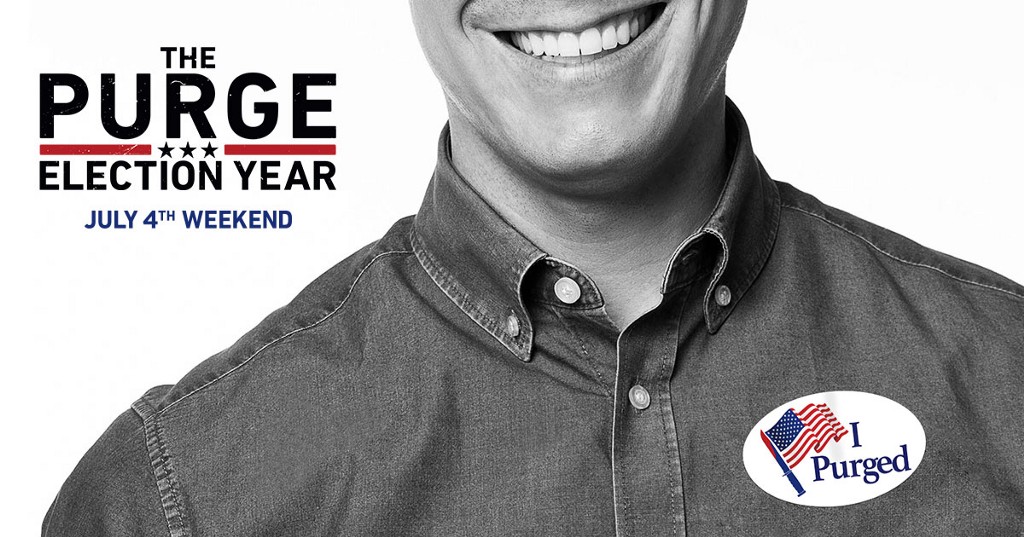The Purge: Election Year Makes America Bloody Again
The third chapter is the weakest link in the Purge series.

Since its inception in 2013, writer/director James DeMonaco’s The Purge series has consistently grown in scale and scope in its depiction of a dystopian America that legalizes all crime – including violent murder – once a year for 12 hours. Set entirely inside the home of an affluent family, the first film – a surprise, low budget hit – only scratched the surface of complex class conflicts and race relations that lie at the heart of its nightmarish (and yet, strangely real-feeling) scenario. Still, it used its limited resources shrewdly in creating a gripping home invasion thriller, while lightly (albeit frustratingly) teasing an unfamiliar world outside the four walls, the rules of which it hadn’t necessarily fully figured out yet. Smartly carrying the story out to the streets, The Purge: Anarchy – the best film of the series – delivered upon that intrigue and told a first-rate survival tale amid a grassroots movement growing against the violent American tradition where the rich, white citizens feed off and systematically erase the socially and economically underprivileged.
The Purge: Election Year, the third (possibly not last) film of the chain, is more violent, action-packed and set piece focused than its two predecessors. That might sound sexy and appealing at first; but the philosophical nuances, drown out by the torture porn inclinations The Purge: Election Year occasionally indulges in prove otherwise. Election Year is still a thrillingly fun ride (and as compulsively watchable as the two that came before it), but it’s more in the mindless slasher tradition of the Saw franchise (with methods of physical torment ranging from guillotines to drones), even though the first two films carefully and incrementally paved the way to something a lot more political and out of the ordinary. And that’s strange, because on paper, Election Year (if the title isn’t obvious enough) is the most loudly political of the three films with an “America’s Choice” backdrop. But whether it manages to fully relish the opulence at its disposal is another story.
It’s two years after the events of the previous film, with two days to go till the annual purge. The New Founding Fathers – imagine them as a hyper-conservative and powerful cult made up of prominent figures of the Tea Party movement – have been growing restless toward a swelling underground uprising (the signs of which we’ve witness in Anarchy), designed to get rid of the poor, strengthen the rich and exploit the fears of the middle class.
Finally standing up to this annual ruthless violence is an independent Senator and Presidential nominee named Charlie Roan (capably played by Elizabeth Mitchell) – a Hillary-Clinton-meets-Elizabeth-Warren-type idealist – who lost her family on purge night when she was a kid (as the film’s opening shows us in all its depravity.) Surely, the NFFA wants her destroyed against their candidate Minister Edwidge Owens (Kyle Secor) and enables her assassination by removing the immunity of government officials from the festivities (a revised rule to the Purge universe). Protecting the Senator officially is Leo Barnes (Frank Grillo, returning from the second film) who joins forces with the proud, hardworking deli owner Joe Dixon (Mykelti Williamson), his Mexican immigrant novice Marcos (Joseph Julian Soria) and the badass paramedic/self-appointed Purge night savior Laney (Betty Gabriel, the film’s true standout talent) during a blood-washed night of utmost terror. Along the way, they meet Dante Bishop (Edwin Hodge, a stable character since the first movie): the leader of the underground vigilante movement with eye-for-an-eye violent methods the Senator doesn’t necessarily approve of.
At times, Election Year plays like a Harry Potter installment where “The Order of the Phoenix” tries to protect the Chosen One against Lord Voldermort and his Death Eaters. Other times, when it cuts closer to the bone, it becomes a disconcerting cinematic taste of what a Trump presidency would theoretically look like. This combination somehow gives the film a certain, heavy-handed self-righteousness that sometimes comes across as rather ludicrous. The camerawork in certain segments doesn’t help with this weird silliness either, especially when it purposefully waters the mouth of the audience with anticipation of some impending cutting, slaying and slashing. In one especially false-natured scene, the camera surveys the costumes and bodies of annoying and potentially violent female attackers, collecting the hatred of the audience only to instigate their celebratory cheers later on, once the good guys murder the perpetrators in gruesome detail. This tease technique repeats itself a number of times, coming dangerously close to making a dimwitted “good guy with a gun can take out a bad guy with a gun” argument: a philosophy that the Senator is dead against.
The film’s most noteworthy dimension is its firm grip on race dynamics: Election Year gives people of color real agency in determining their own faith and defending themselves against a corrupt structure that systematically oppresses them. As Joe Dixon, ready to fight against whomever comes his way, puts it: “you should never sneak up on a black man on purge night.” Rightfully mad as hell and prepared to die for their cause and pride, the people of color – who enable a peaceful politician to work for their needs and priorities – are the ones to remember from Election Year.
